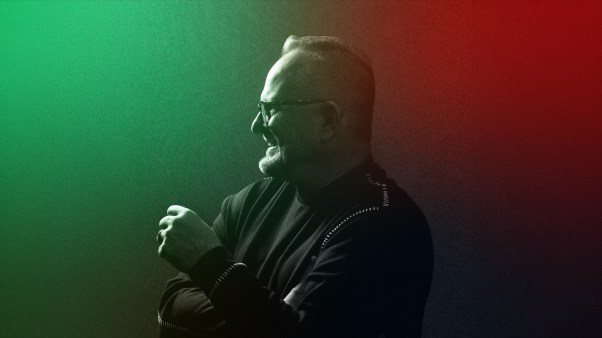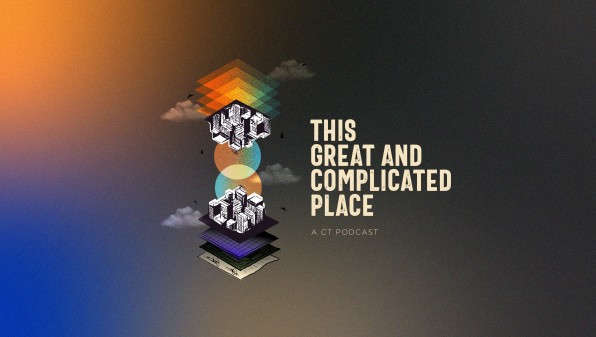Where is God?
The Face of the Deep: Exploring the Mysterious Person of the Holy Spirit
David C Cook
304 pages
$24.92
It is a question that haunted me since I first met him as a boy. It is the type of question that has more than one referent, more than one significance for a life. One can satisfy the mind with a theological answer, but remain held by some visceral, gut-level longing. Is God truly here?
Fortunately, I believe that God has already provided a way to live that answer, indeed that he provided it long before our race could frame the words.
In talking about “where” God is, Christians are forced to retain two equal and (seemingly) opposing truths. We must with one hand cling to God’s transcendence—the doctrine that the triune God is utterly and infinitely beyond creation; and with the other to his immanence—the doctrine that he is utterly and infinitely close to his creation.
Christians have not always done well holding the two in balance. A quick survey of Christian literature, oratory, and art indicates that we prefer to emphasize transcendence over immanence. The truth that God is beyond all too often trumps the truth that God has chosen to be here with us—and “here” beyond any categories of time or space as we think of them.
From one perspective, this is understandable. After all, we’re here already, and here is a bit of a mess. We must look beyond, for the transcendent power of God from outside our experience of time and space to intersect our world in justice, meaning, and redemption. It is our only hope of salvation. But it is a meaningless hope if he did not dwell immanently with us here and now.
Here is the truth, historic and orthodox: When we look out at the world, we look out at a place where God the Creator is actively dwelling and working to sustain what he’s made.
It is of this truth that Paul spoke, when he quoted Epimenides of Crete on Mars Hill, saying that “in [God] we live and move and have our being.” In the preceding oration to that lovely line, the apostle argues,
The God who made the world and everything in it is the Lord of heaven and earth and does not live in temples built by human hands. And he is not served by human hands, as if he needed anything. Rather, he himself gives everyone life and breath and everything else … so that they would seek him and perhaps reach out for him and find him, though he is not far from any one of us. (Acts 17:24–27)
Paul’s discourse brilliantly illustrates the simplicity of the Christian story of creation: God made everything, and he never left it. So you there, you runner from God, reach out. He is closer than you know.
For Paul, of course, the point of talking about any of this is to reinforce the clearest unity of the Creator’s transcendence and immanence—the resurrected Jesus. And this should be the center point of the haunting doctrine for us, too.
But the implications of this story touch every thread of the world’s weave. If it is true that in God we live and move and have our being, then what does that mean for life, spiritual and physical? Indeed, might those two be more intertwined than we think?
The best Christian conception of reality is very simple: The uncreated One is the source of all things. From one perspective, any sense of distance from the Creator is an illusion. It is mythical (though of course God remains transcendent over all, and our sin causes a degree of relational distance). My haunting question, from one perspective, is answered by simple existence. Where is God? Closer than we remember.
The Symphony of Life
As I write this, I look out my window to a tumbledown stone wall bordering my family’s little creek. Plush green moss sits on the stones, and birds flit across the moss—chickadees and Northern Flickers and deep indigo Steller’s Jays, their black crests rakish with mischief. Goats graze in the little field beyond, dappled in light. The runt among them is limping. Roses among the stones are beginning to bud, tentatively feeling if the frosts are gone.
Our doctrine of immanence teaches that each of these things is full of the Spirit, a dwelling-place of God, limited by nature but still full of the presence of the Almighty. In him they live and move. In him they have their being. The Creator is distinct from creation, without question, but the truth remains that I live and move and have my own being among others made in the image of the great Maker.
By learning, knowing, naming my world, I see God, gentle in presence. The transcendent One is waiting for me to experience and recognize him here. To remember him here. This is the God of Sinai, the uncreated One, whose breath rustles the dry leaves and scatters pebbles in the driveway. This is the nature of the beloved Son that leaps in my heart at the sight of a friend. He is here.
All of life becomes a symphony of God’s own music. He, the composer and conductor, directing us each to know and reveal as only our individual natures can know and reveal him.
Painting the Cosmos
To discuss this immanence of God with anything approaching accuracy, we must look first at his transcendence. God’s quality of aseity affirms that he is perfectly self-existent. He looks to nothing as his source. Rather, he is the source of everything, including himself.
The life of the Trinity, from all eternity, has been complete and whole. The persons of the Godhead depend on nothing, dwelling from all time in perfect relationship, power, and glory. They are one in perfect unity, three in perfect diversity. What is true of one is true of all.
And this triune God made all things, perfect in wisdom and the power of his word. This was Trinitarian work, involving all the persons of the Godhead. A biblical theology of creation sees the Son (John 1:3), the Father (1 Cor. 8:6), and the Holy Spirit (Gen. 1:2-3) all involved in making the universe of the “things that are seen” (2 Cor. 4:18). The One-in-Three, who from our vantage point is transcendent beyond any category of place or time, makes all places and times, including our place, our time. Including now. Including us.
This is the backdrop to the drama of creation—the uncreated Creator painting the cosmos, himself the palette, the canvas, the brush—for any other medium is unimaginable. All springs from the only source possible for anything: God, who makes and sustains all through his ancient word of life.
A Spirit Story
Once we begin to trace the outlines of God’s immanence, we quickly see that the story of his closeness to the world and to those made in his image is a Spirit story. Why? The answer lies in his distinctiveness among the members of the Trinity. The blazing uncovered glory of the Father does not pair well with human life as we currently experience it—think of Moses begging to see God’s face. “No one may see me and live,” the uncreated One says to the prophet on the holy mountain. The Father’s closeness to creation maintains distance, loving fury veiled in cloud and flashes of lightning, the shrieks of six-winged cherubim rending eardrums and causing us to fall prone, crying like Isaiah that we are undone. We are never allowed to forget his Sourceness, his almighty power and utter authority. His kingship and fatherhood so deep that nothing is outside his decree, all is sourced from his perfections.
The Son, unmade yet eternally begotten, became incarnate as Jesus of Nazareth, prone to limitations of a human body. That blessed body, Scripture says, sits at the right hand of the Father in heaven even now, at this moment, from whence he will come to judge the living and the dead. His incarnation is glorious in its chosen limitations, but limited nonetheless.
But the Spirit? He is able to be immanent, close, intimate in a way that is distinct from the ways the Father and Son can. His presence can be gentle, unbounded by body or place. His omnipresence is perfect, yet his personality and divinity are unquestionable. He is God, the uncreated Creator from before any beginning of beginnings, perfect and transcendent. And yet able to be here in a way of true and gentle love for his people. He may remain hidden, invisible, but it does not diminish his presence or his power. And in him, Creator and Sustainer, we live, and move, and have our being.
This is not to say that the Trinity has three natures. God is one, and his nature is one. Nor is it to affirm the idea that he takes on different forms in different places. It simply says that the various persons of the Trinity work in different ways, consistent with the one nature and the distinctives of each of the three.
Is the whole Trinity immanent? Yes, but not in the same ways. And it is the Spirit’s ways of immanence that I believe we most often forget, to our great loss.
What do we lose? We lose the capacity for seeing the wonder and wisdom of God in places where we commonly overlook it. We lose the daily holy awareness that in God’s economy there is nothing worthless that he has made. We lose the chance to have the visceral, unspoken realities of embodied life become paths of sanctification and quiet worship for us. We lose the chance for God’s closeness in the world to give holy quiet shape to our inner lives. We lose the chance to know him, even if just a little, by noting his close presence.
He Is Close
Immanence intersects us. The divine Spirit who draws near is not only close to the forests and creeks, he is close to the cities, to the suburban sprawls, to the work of our hands. He is close to the Bible’s great narrative—the means of Mary’s miraculous conception, the empowering fire of Pentecost, the guide and Comforter of the apostles and early church. He is close to the life of our hearts. All the classic works of the Holy Spirit—baptism, illumination, sealing, sanctification—are immanent works. He must be close to work as intimately in our lives as our doctrine tells us he does. His immanence extends to community and church—“One spirit,” Paul says in Ephesians, and wherever two or more are gathered, the Spirit of Jesus is in our midst (Matt. 18:20). Close. Here.
John Stott wrote that during moments of particular worship or awareness of the Spirit’s presence, “Sometimes … invisible reality overwhelms us. Time stands still. We step into a new dimension of eternity. We become still and know that God is God. We fall down before him and worship.”
The story of creation and re-creation becomes a Spirit-story. An immanent Spirit-story, at every turn. And we who see it cannot help but fall down before him and worship—not the creation, but the Creator who never left his creation.
His works pull the transcendent power of the God who is beyond all into the reality that we live in, mundane and quiet. And so that power that made and sustains all things makes and sustains us, whole beings called to live God’s life in our individual circumstances. The life of God, through the Spirit, becomes the life of humankind.
Reclaiming our awareness of the Spirit’s immanence begins to unlock holy imagination for our world. We see things, all things, differently, if we understand their relationship that persists even today to their Creator.
Instead of viewing creation as some sort of divine art project—interesting primarily as the past work of God—we see it as his multiform dwelling place, holy because he works and loves there now. A place of his activity and goodness, limited or flawed as those places may be. Limited and flawed as we may be.
‘I Have Seene Him’
Basil the Great, one of greatest early theologians of the Holy Spirit, traced the implications of that closeness to creation in a famous passage. He taught that the Spirit is
boundless in power, unlimited in greatness, immeasurable by time or by aeons, bountiful in his good gifts; unto whom all things turn when they need holiness, whom all things long after that live according to virtue. . . . Perfecting all others, himself wanting in nothing, not living himself by removal but the giver of life; not growing by accessions, but at once complete, stablished in himself and existing everywhere. The source of holiness; the intellectual light; giving to every rational power a certain enlightenment from himself for the discovery of truth. By nature unapproachable; comprehensible by his own graciousness. Filling all things by his power, yet communicable to the worthy alone. Not communicated to all in the same measure, but distributing his energy according to the proportion of faith. Uncompounded in his essence; various in his powers. Wholly present to each, and wholly present everywhere. Divided without passion; being shared, yet remaining whole, like a ray of the sun, whose favor to him who enjoys it is as if to him alone, but which shines over land and sea, and is diffused into the air. Even so the Holy Spirit, while he is wholly present to every one capable of receiving him, infuses into all a grace complete and sufficient, so that partakers enjoy him according to the measure of their ability, not of his power.
Holding the transcendence of God the Spirit firmly in hand, Basil traces his presence into everything, though not revealed to the same degree—the immanent Spirit is not approached through the body but through our own spirit, he teaches elsewhere, though he is present, close to creation, to you and me.
Can our awareness of God’s immanent presence lead us to dangerous theology? Of course. It is one of the oldest sins to confuse the Creator with the creation, a sin that the Bible leaves little excuse for. But few Christians today are in any danger of making that mistake, so far have we erred in the opposite direction. We read Scripture thinly. Our imaginations—indeed our eyes to see God—have atrophied.
Think of the images of God’s closeness in the Bible, the poetry of the immanence of his work. He is described as the bird, the striding man, the nursing mother, the lover, the rock, the feathered thing of Psalm 91. The Bible’s images for God fly, stride, float, wash, hunt, breastfeed, sprout, water, and leap from the page. If that surprises us, we have failed to be formed by Scripture.
One of our more pressing sins is shoehorning God into tidy little manicured set-pieces, bounded by sermon podcasts and nifty branding, and forgetting his mystic strangeness, his lovely ferocity, his kinship and closeness with all the rough and breeding things he has made. Even the trees (he says the kingdom is like one), the water (he says his Spirit is like it), and the stones (how our souls ought to long for God like they can shelter our bodies!). All of these become symbols, and more than symbols, means by which the God of creation and redemption meets us here. Today. He bridges worlds, for love’s sake. For his glory.
Balancing his immanence, in person and work, with his transcendence is a tension we must walk. And we must walk it well to engage with him fully, to answer the “where?” in a way that satisfies and involves our whole persons and our entire world, a way that sees him more fully as he is—dwelling close, working close. Intimate in quiet glory.
God delights in painting himself into our world. He loves the poetry of existence, being thought of as the Water behind all water, the Fire from whence every earthly fire leaps. The Bird of heaven, descending dove-like among the jays.
Puritan preacher Walter Cradock agrees—and sees, like so many of us, the diversity of that close encounter in both the so-called holy and the so-called common. He wished that his church members could say,
God hath appeared two hundred times, two thousand times to my soule. I have seen him one while in the Sacrament, I have seene him among the Saints, I have seene him in such a country, in such a condition, in such a place, in such a medow, in such a wood, when I read his word, and called upon his name.
And in the 2,000 times that I have “seene” him, he has appeared to me too.
That balance of transcendence and immanence cannot remain an abstract theological exercise—some cosmic version of hide-and-go-seek. I’d argue that it’s one of the most practical places where “abstract” theology becomes deeply moving and pastorally practical.
“I am,” Annie Dillard wrote in Pilgrim at Tinker Creek, “a frayed and nibbled survivor in a fallen world, and I am getting along…. I am not washed and beautiful, in control of a shining world in which everything fits, but instead am wandering about on a splintered wreck I’ve come to care for, whose gnawed trees breathe a delicate air … whose beauty beats and shines not in its imperfections, but overwhelmingly in spite of them, under the wind-rent clouds, upstream and down. Simone Weil says simply, ‘Let us love the country of here below. It is real; it offers resistance to love.’ ”
It is immanence that is this beauty, the bones and sinews of this beauty. Not in the imperfections, but in spite of. Shining through the cracks in our skins, as it were. The Spirit’s presence here.
There—and Here
Immanence is a doctrine much like a Russian nesting doll—containing truths inside it shaped like itself, compounding the mystery. Truths responding to deep questions: To what degree does God’s presence equal his influence? How do we reconcile that everywhere kind of divine presence with the ubiquity of evil and suffering? Is God as present with the moss and crested jaybirds as he is with me?
Those are questions that must wait today. The stones along the creek are whispering something, promising small deep secrets if I’ll come sit with them and God. I need to go spend some time talking with them.
Let me leave it at this: ever since I began to glimpse his immanence in my own life, it has haunted me. I have learned to see God flutter where I least expected him, to humble myself before his rich and fulsome presence. The Holy Ghost has haunted me, ever present, moving invisibly and well.
Where is God? There. Completely there. And here. Completely.
Here.
Paul J. Pastor is author of The Face of the Deep: Exploring the Mysterious Person of the Holy Spirit (David C. Cook). He lives in Oregon.









